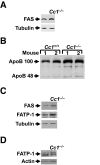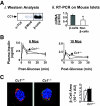Carcinoembryonic antigen-related cell adhesion molecule 1: a link between insulin and lipid metabolism
- PMID: 18544705
- PMCID: PMC2518480
- DOI: 10.2337/db08-0379
Carcinoembryonic antigen-related cell adhesion molecule 1: a link between insulin and lipid metabolism
Abstract
Objective: Liver-specific inactivation of carcinoembryonic antigen-related cell adhesion molecule 1 (CEACAM1) by a dominant-negative transgene (l-SACC1 mice) impaired insulin clearance, caused insulin resistance, and increased hepatic lipogenesis. To discern whether this phenotype reflects a physiological function of CEACAM1 rather than the effect of the dominant-negative transgene, we characterized the metabolic phenotype of mice with null mutation of the Ceacam1 gene (Cc1(-/-)).
Research design and methods: Mice were originally generated on a mixed C57BL/6x129sv genetic background and then backcrossed 12 times onto the C57BL/6 background. More than 70 male mice of each of the Cc1(-/-) and wild-type Cc1(+/+) groups were subjected to metabolic analyses, including insulin tolerance, hyperinsulinemic-euglycemic clamp studies, insulin secretion in response to glucose, and determination of fasting serum insulin, C-peptide, triglyceride, and free fatty acid levels.
Results: Like l-SACC1, Cc1(-/-) mice exhibited impairment of insulin clearance and hyperinsulinemia, which caused insulin resistance beginning at 2 months of age, when the mutation was maintained on a mixed C57BL/6x129sv background, but not until 5-6 months of age on a homogeneous inbred C57BL/6 genetic background. Hyperinsulinemic-euglycemic clamp studies revealed that the inbred Cc1(-/-) mice developed insulin resistance primarily in liver. Despite substantial expression of CEACAM1 in pancreatic beta-cells, insulin secretion in response to glucose in vivo and in isolated islets was normal in Cc1(-/-) mice (inbred and outbred strains).
Conclusions: Intact insulin secretion in response to glucose and impairment of insulin clearance in l-SACC1 and Cc1(-/-) mice suggest that the principal role of CEACAM1 in insulin action is to mediate insulin clearance in liver.
Figures






Similar articles
-
Liver-specific rescuing of CEACAM1 reverses endothelial and cardiovascular abnormalities in male mice with null deletion of Ceacam1 gene.Mol Metab. 2018 Mar;9:98-113. doi: 10.1016/j.molmet.2018.01.009. Epub 2018 Jan 31. Mol Metab. 2018. PMID: 29396368 Free PMC article.
-
Liver-specific reconstitution of CEACAM1 reverses the metabolic abnormalities caused by its global deletion in male mice.Diabetologia. 2017 Dec;60(12):2463-2474. doi: 10.1007/s00125-017-4432-y. Epub 2017 Sep 14. Diabetologia. 2017. PMID: 28913658 Free PMC article.
-
Hyperinsulinemia drives hepatic insulin resistance in male mice with liver-specific Ceacam1 deletion independently of lipolysis.Metabolism. 2019 Apr;93:33-43. doi: 10.1016/j.metabol.2019.01.008. Epub 2019 Jan 19. Metabolism. 2019. PMID: 30664851 Free PMC article.
-
Regulation of insulin action by CEACAM1.Trends Endocrinol Metab. 2002 Aug;13(6):240-5. doi: 10.1016/s1043-2760(02)00608-2. Trends Endocrinol Metab. 2002. PMID: 12128284 Review.
-
Loss of Hepatic CEACAM1: A Unifying Mechanism Linking Insulin Resistance to Obesity and Non-Alcoholic Fatty Liver Disease.Front Endocrinol (Lausanne). 2017 Jan 26;8:8. doi: 10.3389/fendo.2017.00008. eCollection 2017. Front Endocrinol (Lausanne). 2017. PMID: 28184213 Free PMC article. Review.
Cited by
-
Involvement of a battery of investigated genes in lipid droplet pathophysiology and associated comorbidities.Adipocyte. 2024 Dec;13(1):2403380. doi: 10.1080/21623945.2024.2403380. Epub 2024 Sep 27. Adipocyte. 2024. PMID: 39329369 Free PMC article. Review.
-
Hepatic Insulin Clearance: Mechanism and Physiology.Physiology (Bethesda). 2019 May 1;34(3):198-215. doi: 10.1152/physiol.00048.2018. Physiology (Bethesda). 2019. PMID: 30968756 Free PMC article. Review.
-
Liver-specific rescuing of CEACAM1 reverses endothelial and cardiovascular abnormalities in male mice with null deletion of Ceacam1 gene.Mol Metab. 2018 Mar;9:98-113. doi: 10.1016/j.molmet.2018.01.009. Epub 2018 Jan 31. Mol Metab. 2018. PMID: 29396368 Free PMC article.
-
Increased metabolic rate and insulin sensitivity in male mice lacking the carcino-embryonic antigen-related cell adhesion molecule 2.Diabetologia. 2012 Mar;55(3):763-72. doi: 10.1007/s00125-011-2388-x. Epub 2011 Dec 11. Diabetologia. 2012. PMID: 22159884 Free PMC article.
-
Conditional deletion of CEACAM1 in hepatic stellate cells causes their activation.Mol Metab. 2024 Oct;88:102010. doi: 10.1016/j.molmet.2024.102010. Epub 2024 Aug 19. Mol Metab. 2024. PMID: 39168268 Free PMC article.
References
-
- Duckworth WC, Bennett RG, Hamel FG: Insulin degradation: progress and potential. Endocrinol Rev 19 :608 –624,1998 - PubMed
-
- Shillabeer G, Hornford J, Forden JM, Wong NC, Russell JC, Lau DC: Fatty acid synthase and adipsin mRNA levels in obese and lean JCR:LA-cp rats: effect of diet. J Lipid Res 33 :31 –39,1992 - PubMed
-
- Assimacopoulos-Jeannet F, Brichard S, Rencurel F, Cusin I, Jeanrenaud B: In vivo effects of hyperinsulinemia on lipogenic enzymes and glucose transporter expression in rat liver and adipose tissues. Metabolism 44 :228 –233,1995 - PubMed
-
- Rabkin R, Ryan MP, Duckworth WC: The renal metabollism of insulin. Diabetologia 27 :351 –357,1984 - PubMed
-
- Formisano P, Najjar SM, Gross CN, Philippe N, Oriente F, Kern BCL, Accili D, Gorden P: Receptor-mediated internalization of insulin: potential role of pp120/HA4, a substrate of the insulin receptor kinase. J Biol Chem 270 :24073 –24077,1995 - PubMed
Publication types
MeSH terms
Substances
Grants and funding
LinkOut - more resources
Full Text Sources
Medical
Molecular Biology Databases
Miscellaneous

